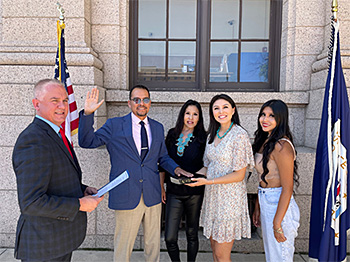June 16, 2022
First Native American installed as Colorado Springs, CO, Postmaster
Thursday, June 16, 2022 ceremony

From Left, Colorado/Wyoming District Manager Jason McMahill, Postmaster Steve Begay, Steve’s wife Gayla and daughters Autumn and Tatumn Begay during the administration of the Oath of Office.
Stevenson “Steve” Begay 26th Postmaster of Colorado Springs since 1871
Steve Begay was installed as Postmaster of Colorado Springs, CO, on Thursday June 16, joined by family, friends, and community members. Colorado/Wyoming District Manager Jason McMahill administered the Oath of Office.
Steve began his postal career in Tempe, AZ as a letter carrier in 1999. He has served as Supervisor Customer Service, Manager Customer Service Operations, Manager Post Office Operations in Denver, CO, Postmaster of Farmington, NM and Postmaster of Yuma, AZ among other positions.
Steve is a Graduate of the Managerial Leadership Program and is Lean Six Sigma Green Belt Certified. Steve is a military veteran that honorably served in the United States Marine Corp before coming to the United States Postal Service.
“I’m honored to be the Postmaster of Colorado Springs,” said Begay. “I will work hard to give great service to our employees and customers.”
The History of the Postmaster Position
Originally, the word Postmaster was referred as the one who provided post horses. According to the Oxford Dictionary, postmaster means “master of the posts, the officer who has charge or direction of the posts.”
William Penn established Pennsylvania’s first post office in 1683. However, the real beginnings of a postal system in the colonies dates from 1692 when Thomas Neale received a 21-year grant from the British Crown authorizing him to set up post roads in North America.
In 1707, the British Government bought the rights to the North American postal service, and, in 1710, consolidated the postal service into one establishment. The principal offices of the new British Postal Service were in London, England; Edinburgh Scotland; Dublin, Ireland, and New York.
In 1737, Benjamin Franklin was appointed Postmaster at Philadelphia. He laid out new post roads, helped expand mail service from Canada to New York and instituted overnight delivery between Philadelphia and New York City, a distance of 90 miles. In 1774, Franklin was dismissed from office in 1774 because of his efforts on behalf of the patriots.
When the Continental Congress met in May 1775, they named Franklin as postmaster general for the 13 American colonies.
From 1775 until the early 1800s, Postmasters were appointed by the postmaster general. In 1836, postmasters were appointed by the president, but this of course changed whenever a new party was elected. It was not until August 1970, with the signing of the Postal Reorganization Act, which to effect in July 1971, that the patronage system was finally removed from the postal service once and for all. Postmasters began being appointed on merit alone.
The act also permitted upward mobility for line employees, allowing them to be promoted to the position of Postmaster.
Along the way, there have been several famous individuals, who have served as postmasters. In 1833, Abraham Lincoln was appointed postmaster of New Salem, IL.
Other notable individuals who served as postmaster somewhere in the U.S. included abolitionist John Brown, businessman Conrad Hilton, novelist William Faulkner, and humorists Bill Nye and Mark Twain.
The Postal Service generally receives no tax dollars for operating expenses and relies on the sale of postage, products and services to fund its operations
###
USPS NEWS
Media contacts
-
James Boxrud
James.N.Boxrud@usps.gov
303-313-5134
970-278-6607 M
